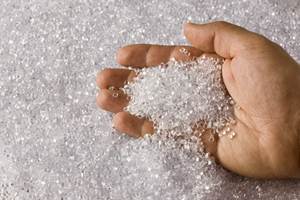Coextrusion Adds Shine to PP For Thermoforming Large Parts
New coextruded resin combinations are making polypropylene a contender for large thermoformed parts in outdoor uses from pleasure boats to automotive exterior trim.
New coextruded resin combinations are making polypropylene a contender for large thermoformed parts in outdoor uses from pleasure boats to automotive exterior trim. A major developmental program at Montell Polyolefins, Wilmington, Del., is aimed at giving PP-based sheet the right combinations of processability, glossy appearance, and ruggedness to compete cost-effectively with weatherable styrenics, acrylic, and even fiberglass/polyester thermoset composites.
Montell's strategy is to use multi-layered combinations of different resins in its PP-based portfolio
Montell believes that "integrated systems" are necessary because no one material can provide the specific combinations of properties
At this point, the main focus is on thermoforming coextruded sheet. (For development purposes, Montell has installed a Battenfeld Gloucester three-extruder sheet line capable of making two- and three-layer sheet up to 48 in. wide.) However, this concept can be applied to other multi-layer processing techniques like coinjection molding, coextrusion blow molding, and even low-pressure injection molding of PP behind an insert of preformed sheet/foam laminate.
High-melt-strength sheet
Virtually all Montell's thermoformable structures are based on the company's family of high-melt-strength PP, the Pro-fax HMS series. The goal is to combine a core of HMS PP with a cap layer of another Montell resin chosen for gloss or other functional properties.
In thermoforming, PP has been limited mostly to solid-phase forming of small packaging items. Large-part thermoforming has been traditionally constrained by the inherently low melt strength of PP and its loss of gloss during forming. With the introduction of Montell's HMS family of PP homopolymers and copolymers in the early 1990s, large parts could be thermoformed in the melt phase. Electron-beam radiation is used to induce long-chain branching in PP, which enhances melt strength. "HMS PP was developed for its resistance to sag in the molten phase," explains senior technology manager Alam Shah. HMS is also used to make foams and extrusion coatings.
"While the Pro-fax HMS family essentially took care of PP's melt-strength limitations, it did not address the gloss required in most types of large thermoformed parts, such as auto exterior panels. The integrated-systems approach brings these together," says Jim Keeler, advanced program manager at Montell's Automotive Business Group.
Three products in the HMS family are said to be particularly suited to large-part thermoforming and blow molding. Pro-fax PF716 homopolymer (1.8 MFR) has a tensile yield strength of 5400 psi, flex modulus of 240,000 psi, HDT of 247 F at 66 psi, and notched Izod impact of 1.3 ft-lb/in. Pro-fax SD613 heterophasic copolymer (0.45 MFR ) has a tensile strength of 4400 psi, flex modulus of 190,000 psi, HDT of 221 F, and "no-break" notched Izod. The third product, Pro-fax PF623 homopolymer (15 MFR), is a melt-strength enhancing additive for extrusion.
Candidates for a cap layer can include Hivalloy W (PP/PMMA) or one of several "soft-touch" TPOs or PP copolymers. Montell says it has patent-pending materials in development, but no details were disclosed.
Technology becomes reality
Montell has several active programs with major sheet producers and thermoformers. "We are now running PP-based materials 0.1 to 0.3 in. thick on conventional heavy-gauge thermoforming machines," says Formaro. Montell has produced large thermoformed parts with 60° gloss values over 80% and ductile impact behavior at sub-zero temperatures. Flexural modulus can be tailored over a wide range (see table). At the higher stiffnesses, thermoformed PP reportedly can compete with FRP composites in car and truck parts, marine uses, and spas.
The first commercial large-part thermoformed application is the deck of new power boats that can be rented at Walt Disney World in Orlando, Fla. Coming soon are large body panels for cars and all-terrain vehicles.
The deck of the 9-ft Disney World boat is thermoformed from a coextruded sheet of which 80% is a core of HMS PP and 20% is a cap layer of a highly crystalline specialty grade of PP, reports Shah. Compared with the coextruded ABS/ASA sheet formerly used, it is said to have at least twice the impact resistance and much higher chemical resistance. After forming, gloss level (60°) of the PP sheet is over 80%, equal to that of ASA-capped ABS. Due to its excellent formability, HMS PP sheet of 0.275 in. reportedly yields greater part thickness in deep-draw areas than does ABS/ASA sheet of 0.318 in. Downgauging translates into a significant cost advantage over the incumbent material, says Shah.
Related Content
In Sustainable Packaging, the Word is ‘Monomaterial’
In both flexible and rigid packaging, the trend is to replace multimaterial laminates, coextrusions and “composites” with single-material structures, usually based on PE or PP. Nonpackaging applications are following suit.
Read MoreThe Fundamentals of Polyethylene – Part 1: The Basics
You would think we’d know all there is to know about a material that was commercialized 80 years ago. Not so for polyethylene. Let’s start by brushing up on the basics.
Read MorePrices Up for PE, PP, PS, Flat for PVC, PET
Trajectory is generally flat-to-down for all commodity resins.
Read MoreFirst Quarter Looks Mostly Flat for Resin Prices
Temporary upward blips don't indicate any sustained movement in the near term.
Read MoreRead Next
Understanding Melting in Single-Screw Extruders
You can better visualize the melting process by “flipping” the observation point so that the barrel appears to be turning clockwise around a stationary screw.
Read MoreWhy (and What) You Need to Dry
Other than polyolefins, almost every other polymer exhibits some level of polarity and therefore can absorb a certain amount of moisture from the atmosphere. Here’s a look at some of these materials, and what needs to be done to dry them.
Read MoreProcessor Turns to AI to Help Keep Machines Humming
At captive processor McConkey, a new generation of artificial intelligence models, highlighted by ChatGPT, is helping it wade through the shortage of skilled labor and keep its production lines churning out good parts.
Read More

























